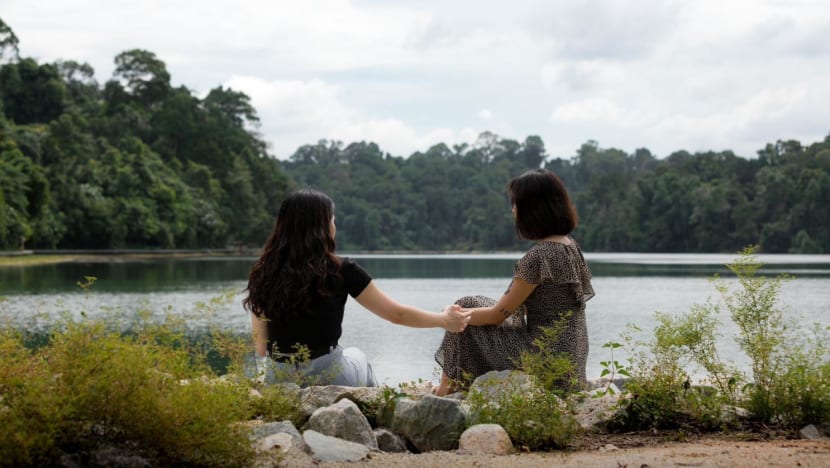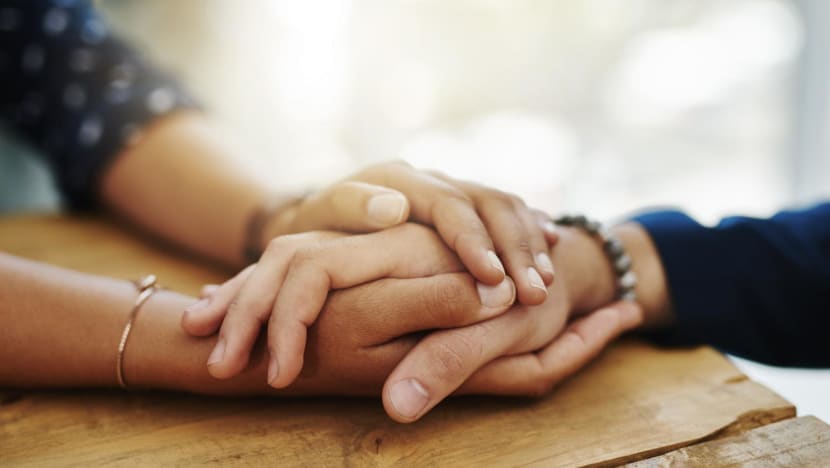'When I help people, I'm also healing': The Samaritans behind a new suicide recovery support group
A new group launched by the Samaritans of Singapore aims to help those who attempted to take their own lives by hearing the stories of those who are recovering.

File photo of two women talking. (Photo: Samaritans of Singapore)
SINGAPORE: When Cath (not her real name) was attempting to take her own life slightly more than a year ago, she never thought she would one day be the person encouraging others to open up about suicide.
The 22-year-old is an “encourager” in Light in the Dark – a new support group launched by the Samaritans of Singapore (SOS) to help those who have attempted suicide or have suicidal thoughts.
The group comprises a facilitator who is an SOS counsellor, participants, and people like Cath - those who have previously tried to die by suicide. For Cath, the journey of recovery is one she is still on.
“When I help people, I’m also healing,” she said.
In Singapore, suicide is the leading cause of death for those aged 10 to 29. In 2021, 378 people in the country took their own lives - with this age group forming the biggest proportion.
It was not very long ago that Cath was going through her own struggles.
What is the Light in the Dark group?
The support group meets every Wednesday and has about eight to 15 members regularly. An SOS counsellor runs the group, and other facilitators with “lived experience” also take part.
The group aims to provide a platform for people with a history of suicide attempts or who struggle with suicidal thoughts to seek help.
The participants go through an assessment before they can join the group. This assessment ensures they are not at high risk of suicide or need immediate help, explained Shawn Lai, SOS senior counsellor and team lead for the crisis and counselling team.
The sessions contain psychoeducational elements that teach people new coping strategies to manage their suicidal ideation or crisis. It is meant to complement existing counselling services and offers another platform for people to seek help.
Currently in its second run – the first after a pilot last year – and the plan is to run it on a regular basis.
Growing up, Cath was regularly bullied and in time, fell into depression. When she turned 17, she started to dissociate from society and developed insomnia.
She was diagnosed with social anxiety at 17 but she was not ready to go through with the therapy, and tried to overcome it herself.
But by 2021, studying became difficult and as she battled the anxiety, she tried to take her own life.
“I can’t count how many times I actually attempted suicide,” she said.
“I didn’t feel any warmth, that’s the reason why I felt like I wanted to die,” Cath added.
Finding support was difficult. “I felt very alone,” she said.
Growing up, she was taught that feeling suicidal was taboo. Her friends invalidated her feelings, saying it was “not a big deal”.
“I felt I had no one to turn to. That’s when I went to SOS and I went for counselling … and then slowly and surely my parents started to be a little bit open minded to what I’m going through,” she explained.
Conversations with her family led them to realise Cath's struggle. Her parents reached out to her, but caring for someone who was thinking about dying was difficult.
“The person who is being the caregiver for the person who is mentally ill is also having a tough time. I try to empathise with (my mother),” she said, recalling the turning point for her family.
“She looked me in the eyes and she said yes, she would go for all these workshops, all these talks. And from there, I could notice that when I’m having my episodes, she would be very terrified and become (anxious).
“But we will sit down and talk and I would say, this is what you should do. So instead of shouting at me, she started to listen to me - reminding me to breathe in, and being gentle with me. From then on, I think I’ve become closer to her.”
In February last year, she was diagnosed with bipolar disorder and she was given medication. Shocked to get a new diagnosis, it left her lost and confused.
But as she started to adapt and learn about the condition, she realised it did not have to define her.
She took part in the pilot run of Light in the Dark, which ran in July last year for 12 weeks. Empowered by her experience, she decided to take part in the next run, which is ongoing.
Shawn Lai, a senior counsellor at SOS who runs the group, explained that the encourager role was carved out for Cath.
“We realised she has a story, and it encourages other members. We wanted to scope a role that will help her to bring out her story because it helps her. At the same time, it’s a way to involve her in a greater capacity,” he explained.
“It’s her journey. It’s to help her to see greater meaning in how her experience can help others.”
With people like Cath in the group, there has been a “synergy” between the participants – suicidal people in recovery.
By opening up, her experience resonated with the participants and they find similarities in their difficulties.
“It helps them to feel less alone, knowing that there are other people like them who are going through similar struggles,” said Shawn.

One person who understands this is Luke Tan, 43, who shared with the group his story about attempting to take his own life.
Luke struggled in a difficult relationship when he was in Australia in his 20s and 30s. During the global financial crisis, he lost his job as an account manager in an events company.
“That was the start of my downward spiral. Coupled with the fact that my relationship wasn’t ideal - it was toxic in a way for both of us - it was a big issue in my life,” he said.
As things hit a low, he tried to kill himself during a drug-induced psychosis when he was about 30.
After smashing his head on a car window, paramedics found him lying face down in a pool of blood.
“I didn’t know what happened. Emergency services came and only in the ambulance did I find myself cocooned up in blankets … by the time I got to the emergency room all my clothes were all crusty (with blood),” he said.
Shortly after that, he was arrested while at a party and spent a night in a holding cell.
“I did not once again address the core issue, which was the relationship … I was pretty much living a hedonistic lifestyle. My partner found out that I was unfaithful to her and finally that blew everything wide out in the open.
“The friends I thought I knew - my closest network literally turned their backs on me instantly … there was extreme shame, guilt, self disgust - that was really the lowest point of my life.”
He decided to turn his life around and focused on becoming a bodybuilder and personal trainer.
As he climbed back on his feet, Luke also met his wife Emily - someone he said was at the "start of my journey".
“She was there for me, and she was someone I could be fully open and honest with because she knew me at my lowest, she met me at my lowest,” he said.
He added: “We built our relationship on brutal honesty and trust, and having that honesty and trust, I share everything.”
When he came back to Singapore in 2015, he started working with SOS and is now part of the Light in the Dark programme.
“It’s become a compass for me. It’s given me a direction to focus, to feel and to support as well, and to know that I’m helping someone in an area that I’ve struggled with,” he said.
The number of people seeking help from a suicide prevention centre has more than doubled over the COVID-19 pandemic, with many contacting the Samaritans of Singapore on its text messaging service. Most of these new clients are under the age of 30. Aslam Shah with more.
Shawn said the group has been meeting regularly, and the participants are drawn to spending time together.
"They have felt that it is helpful in making sense of where they are, and also very much feeling that there are others like them - normalising the struggles and (dispelling) the stigma," he added.
The group is between the ages of 21 and 35.
"Many of them share that because of all the transitions they're experiencing – whether it is work, starting a family, money issues, buying an HDB flat – it causes them a lot of emotional stress," said Shawn.
Normally when someone goes into a suicide crisis, they become overwhelmed and feel hopeless about their situation, he added.
Seeking help is the first step, but Shawn acknowledges it can take a while.
"We value life. We want to work with people going through a struggle, and we can walk with you through that process."
Where to get help:
National mental health helpline: 1771
Samaritans of Singapore Hotline: 1767
Singapore Association for Mental Health Helpline: 1800 283 7019
You can also find a list of international helplines here. If someone you know is at immediate risk, call 24-hour emergency medical services.

















